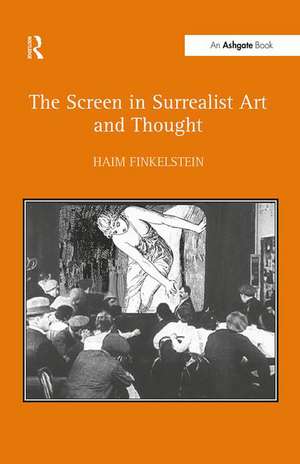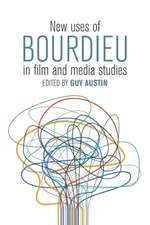The Screen in Surrealist Art and Thought
Autor Haim Finkelsteinen Limba Engleză Paperback – 9 sep 2016
| Toate formatele și edițiile | Preț | Express |
|---|---|---|
| Paperback (1) | 489.26 lei 6-8 săpt. | |
| Taylor & Francis – 9 sep 2016 | 489.26 lei 6-8 săpt. | |
| Hardback (1) | 1061.69 lei 6-8 săpt. | |
| Taylor & Francis – 23 iul 2007 | 1061.69 lei 6-8 săpt. |
Preț: 489.26 lei
Nou
Puncte Express: 734
Preț estimativ în valută:
93.64€ • 101.08$ • 78.52£
93.64€ • 101.08$ • 78.52£
Carte tipărită la comandă
Livrare economică 19 aprilie-03 mai
Preluare comenzi: 021 569.72.76
Specificații
ISBN-13: 9781138275089
ISBN-10: 1138275085
Pagini: 340
Dimensiuni: 156 x 234 x 18 mm
Greutate: 0.45 kg
Ediția:1
Editura: Taylor & Francis
Colecția Routledge
Locul publicării:Oxford, United Kingdom
ISBN-10: 1138275085
Pagini: 340
Dimensiuni: 156 x 234 x 18 mm
Greutate: 0.45 kg
Ediția:1
Editura: Taylor & Francis
Colecția Routledge
Locul publicării:Oxford, United Kingdom
Cuprins
Contents: Introduction; Desnos's screen, Aragon's windowpane, Feuillade's 'self-aware screen'; Beyond the surfaces of the real; Breton's windows; Max Ernst - conceptualization of mental space; Magritte's layered depth; Dialectics of opacity and transparence - Miro; Dialectics of containment and dispersal - Masson; Into the 1930s - eclipse of the screen paradigm; Bibliography; Index.
Notă biografică
Haim Finkelstein holds the Evelyn Metz Chair in Art History at Ben-Gurion University of the Negev, Israel. His book Surrealism and the Crisis of the Object was published in 1980; his more recent books include two volumes devoted to Dalí, Salvador Dalí's Art and Writing 1927-1942 (1996), and a critical edition of his shorter writings, The Collected Writings of Salvador Dalí (1998). His current research focuses on the notion of space in Surrealist film.
Recenzii
’This publication is a fascinating study of the deeper implications of cinema and the screen for Surrealist theory and philosophy.’ Arlis
’Haim Finkelstein's latest publication follows a line of impeccably researched, scholarly works from the author. This fascinating and erudite book proposes a reading of European Surrealism of the 1920s and 1930s which claims the screen as a dominant conceptual paradigm for the movement.’ The Art Book
’One of Haim Finkelstein’s achievements in this book is to articulate the link between surrealist experiences and everyday experience. The book does a particularly fine job of examining how the former are located on the threshold of the latter; it shows, indeed, that what separates surrealism from conventional understandings of realism may be little more than a permeable screen. Finkelstein has produced a rich and fascinating reading of the surrealist movement during the 1920s. ...All in all, The Screen in Surrealist Art and Thought makes a valuable contribution to the study of surrealism and its place in twentieth-century culture. It can be read with profit by not only art, literary and cultural historians, but by anyone concerned with the effects of technological and cultural modernity on the human imagination.’ H-France Review
’Haim Finkelstein's latest publication follows a line of impeccably researched, scholarly works from the author. This fascinating and erudite book proposes a reading of European Surrealism of the 1920s and 1930s which claims the screen as a dominant conceptual paradigm for the movement.’ The Art Book
’One of Haim Finkelstein’s achievements in this book is to articulate the link between surrealist experiences and everyday experience. The book does a particularly fine job of examining how the former are located on the threshold of the latter; it shows, indeed, that what separates surrealism from conventional understandings of realism may be little more than a permeable screen. Finkelstein has produced a rich and fascinating reading of the surrealist movement during the 1920s. ...All in all, The Screen in Surrealist Art and Thought makes a valuable contribution to the study of surrealism and its place in twentieth-century culture. It can be read with profit by not only art, literary and cultural historians, but by anyone concerned with the effects of technological and cultural modernity on the human imagination.’ H-France Review
Descriere
An interrogation of the notion of space in Surrealist theory and philosophy, this study analyzes the manifestations of space in Surrealist paintings and writings, with a specific focus on the "screen" as a spatial paradigm. Haim Finkelstein here extends discussion of the concepts at stake for Surrealist visual art into the context of literature and criticism. His study sheds new light on the way "film thinking" permeates Surrealist thought and aesthetics.



















